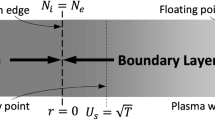Abstract
A collisional plasma flow moving along a magnetic field at a velocity lower than the speed of sound is considered. It has been found that stationary small perturbations increase downstream in the flow. The mechanism of the increase is related to the fact that subsonic ideal-plasma flows respond to external perturbations primarily by a change in the pressure of the plasma. As a result, the pressure under perturbation of the velocity changes so that the stationary flow is decelerated and accelerated if the force is directed along and against the velocity, respectively. This phenomenon can be explained under the assumption that the effective mass of the plasma is negative. If the velocity of the flow is inhomogeneous in the transverse direction, the viscosity force plays a role of the external perturbing force. In this case, the effective transverse viscosity coefficient, which should be treated as negative, can be renormalized instead of the effective mass. The sign of the effective specific heat or the effective transverse thermal conductivity coefficient changes similarly if the velocity of the flow is lower than the speed of sound but is higher than the thermal velocity of ions calculated from the sum of the ion and electron temperatures. A downstream increase in the stationary perturbations is called in this work spatial instability. The downstream growth rate has been determined. The numerical analysis of the evolution of perturbations illustrates the development of the spatial instability of subsonic collisional plasma flows moving along the magnetic field.
Similar content being viewed by others
References
S. I. Braginsky, in Reviews of Plasma Physics, Ed. by M. A. Leontovich (Gosatomizdat, Moscow, 1963; Consultants Bureau, New York, 1963), vol. 1.
A. I. Karchevskii and Yu. A. Muromkin, in Isotopes, Ed. by V. Yu. Baranov (Fizmatlit, Moscow, 2005), vol. 1, p. 307 [in Russian].
A. V. Timofeev, Plasma Phys. Rep. 37, 978 (2011).
A. V. Timofeev, Plasma Phys. Rep. 37, 56 (2011).
L. D. Landau and E. M. Lifshitz, Course of Theoretical Physics, Vol. 6: Fluid Mechanics (Nauka, Moscow, 1986; Pergamon, New York, 1987).
A. Compant, P. Louvet, P. Guerrierec, and A. Pailloux, J. Phys. D 31, 847 (1998).
Author information
Authors and Affiliations
Corresponding author
Additional information
Original Russian Text © A.V. Timofeev, 2013, published in Pis’ma v Zhurnal Eksperimental’noi i Teoreticheskoi Fiziki, 2013, Vol. 97, No. 1, pp. 7–12.
Rights and permissions
About this article
Cite this article
Timofeev, A.V. Stability of the collisional plasma flow in a magnetic field. Jetp Lett. 97, 5–9 (2013). https://doi.org/10.1134/S0021364013010116
Received:
Published:
Issue Date:
DOI: https://doi.org/10.1134/S0021364013010116



